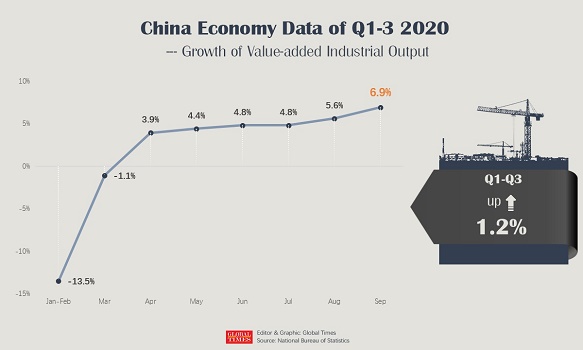China extends economic recovery lead quarter by quarter

China Economic Net
Beijing: China has embraced its best quarterly economic performance of the year in the third quarter (Q3), rendering a 0.7-percent year-on-year expansion for the first nine months as the first major economy to return to growth following the economic fallout of COVID-19.
This marks a striking rebound from a 6.8-percent contraction in the first quarter when the virus took its drastic toll. With the outbreak gradually under control, the economy clawed back growth and notched a 3.2-percent growth in Q2. The third quarter saw a 4.9 percent year-on-year growth.
“Seen from the trends of the key indicators, China’s epidemic prevention and economic recovery are at the world’s forefront, which shows the strong resilience and vitality of the economy,” Liu Aihua, spokesperson of the National Bureau of Statistics (NBS), told a press conference on third-quarter data.
Reflecting upon China’s economic rebound trajectory, it is difficult not to recognize the significance of epidemic control efforts.
Ever since the onset of the COVID-19 outbreak, China has spared no time in saving lives and developed an approach characterized by mass testing, thorough contact tracing, and strict lockdowns, which later brought the epidemic under control.
The containment of a recent hospital cluster in east China’s city of Qingdao, once again, attested to how China’s approach is effective. Over 10 million people were tested within five days, an undertaking unseen worldwide, and the “patient zeros” were traced within the same period, ruling out risks of community transmission.
“China received a total of 637 million visits during the eight-day National Day holiday ending Oct. 8, which demonstrated that the virus has been kept in check,” said Zhong Nanshan, a renowned respiratory disease expert at the opening of the 2020 World Young Scientist Summit on Sunday.
With the same dedication and resolve it put into saving people’s lives, China has worked to cushion market entities and individuals against COVID-19 blows since the early stages of the epidemic, cranking up credit support, slashing fees, and expanding investment.
Official data showed the country’s tax and fee cuts totaled 1.88 trillion yuan (about 280.9 billion U.S. dollars) in the first eight months of the year, benefitting businesses nationwide; from fast fashion boutiques to circuit board manufacturers.
To deliver much-needed liquidity for firms, especially smaller ones, China has come up with solutions, like devising new credit instruments and using tax-paying records to back loans, so that even hog breeders in the agriculture-intensive municipality of Chongqing could receive loans to tide over difficulties.
While employment was affected by the epidemic during the first several months of the year, China has outlined multi-pronged measures to support the resumption of work, facilitate recruitment of key groups, and revive labor demands by encouraging new forms of businesses.
On top of shoring up the economy against COVID-19 headwinds, China has sought to enhance inherent strength for the long haul as companies embraced digital transformation, investment flowed into new infrastructure, and calls for greener growth amplified.
The country’s pledge to install in every county a medical waste disposal system will likely nurture an industry of 11 billion yuan by 2023, and construction of new infrastructures like 5G, AI, and cloud computing could spawn new drivers of domestic demand and attract foreign investment.
Hailing China’s growth as “a positive impulse for the world economy,” Managing Director Kristalina Georgieva of the International Monetary Fund (IMF) said China’s growth is also important for countries that are connected to the Chinese economy through global value chains, as demand from China is an engine for growth there.
Official data showed that foreign direct investment (FDI) into the Chinese mainland, in actual use, expanded by 25.1 percent year on year to 99.03 billion yuan in September, the sixth consecutive month for the country to witness positive growth in FDI.
A bevy of leading global firms, like lift equipment manufacturer JLG, Uniqlo, and Nestle, have announced or made new investments in China this year. Many others reported robust earnings in the country compared with other regions.
“We are confident in the long term prospect of the Chinese market and will continue to invest in the country,” BMW China chief Jochen Goller said.
Challenges remain for China to sustain the growth momentum. NBS’s Liu cautioned that the foundation for sustainable recovery requires further consolidation due to global uncertainties and uneven performances at home.
Yet with the virus now largely under control in China, consumers have streamed back into restaurants and malls, hopped on flights and trains, and packed movie theaters and tourist districts. The Chinese economy is getting increasingly closer to pre-COVID-19 levels.
The IMF projected China’s economy to grow by 1.9 percent in 2020 in its latest World Economic Outlook report, with the global economy expected to post a 4.4-percent decline.
“Overall, China has the foundation, conditions and confidence to maintain the current trend in Q4 and the full year,” Liu said.





